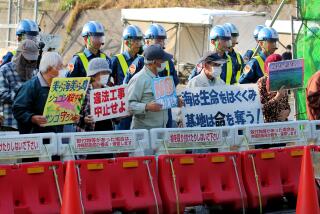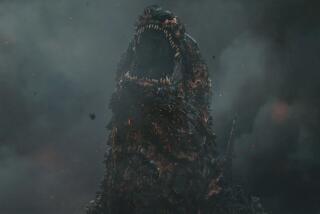They’ve Outlived the Stigma
- Share via
CHIRAN, Japan — These are the dusky days of old age that kamikaze pilots like Shigeyoshi Hamazono were not supposed to see.
Three times during the final months of World War II, Japanese officers sent Hamazono off to die, ordering him to crash-dive a single-engine plane stuffed with bombs into an American warship.
Bad weather aborted the first mission, an oil leak the second. On his final attempt in April 1945, he encountered three American pilots over the sea off Okinawa. In the ensuing dogfight, Hamazono was burned and took shrapnel in his shoulder, but his plane limped home.
You could call him the luckiest man in Japan, though Hamazono didn’t see it that way at the time.
“I was, of course, ready to die,” says Hamazono, who instead has aged into a bent but dignified 81-year-old. Fate allowed him to see his hair turn wispy and gray. And fate made him part of one of history’s strangest and most exclusive brotherhoods: “kamikaze survivors.”
Most were still waiting for orders to fly when Japan surrendered to the Allies in September 1945. A few others were spared because they did not reach their intended targets -- a failure Hamazono found intolerable at the time. He was on standby to fly a fourth mission when Japan capitulated. Denied the opportunity to redeem his honor, he felt disgraced.
“I wished I had died,” he says.
In the postwar years, a traumatized nation treated the kamikaze survivors like pariahs. But in the last decade, their reputation has recovered. Publishers clamor for memoirs. Scholars pick over their backgrounds in search of an explanation for their willingness to die for a lost cause. Japanese nationalists buff and shine their memory like medals.
“Kamikaze” has ceased to be a slur in Japan. If the Japanese still can’t agree on whether the pilots were victims or heroes, brainwashed conscripts or volunteers, they are at least prepared to honor their spirit of sacrifice.
Only the modern menace of the suicide bomber has emerged to spoil this sentiment.
The survivors bitterly resent the world’s appropriation of the term “kamikaze” -- meaning “divine wind” and originally coined to describe the unexpected typhoons that saved 13th century Japan from invading Mongol ships -- as shorthand for suicide bombers of every stripe.
There are the “Al Qaeda kamikazes” who flew passenger planes into office towers, “Palestinian kamikazes” who blow up pizza parlors filled with teenagers in Jerusalem, and “female Chechen kamikazes” willing to detonate explosive girdles in the middle of school gymnasiums crammed with children.
Japan’s originals are insulted to be mentioned in the same breath.
“When I hear the comparison, I feel so sorry for my friends who died, because our mission was totally different from suicide bombers,” Hamazono says as he strolls through the Peace Museum for Kamikaze Pilots in Chiran, a former air base on the southern Japanese island of Kyushu.
The kamikazes attacked military targets. In contrast, “the main purpose of a suicide bomber is to kill as many innocent civilians as they can,” Hamazono says. That, he says, “is just murder.”
The same distinction is made by other survivors of the Tokkotai, or Special Attack Force, conventionally known as the kamikaze. Its survivors tick off the reasons their goal-line stand against an American invasion was different from the blind lashing-out of suicide bombers today:
* They were ready to die out of love for their country, they say; suicide bombers are driven by hatred and revenge.
* The Shinto religion offers no reward of life after death. Islamic suicide bombers are promised a place in an afterlife.
* They were volunteers, motivated solely by patriotism. Suicide bombers often are recruited by militia leaders who offer money to their families.
Yet the arguments can’t prevent those who use suicide tactics today from claiming Japanese kamikazes as an inspiration.
Naoto Amaki, Japan’s former ambassador to Lebanon, recalled delivering a polite lecture to Sheik Hassan Nasrallah, leader of the Shiite Islamist militia Hezbollah, in 2001. Amaki said he told Nasrallah that Japan’s experience was a lesson in the ultimate futility of violence.
Not so, replied the sheik.
“He told me: ‘We learned how to do suicide missions from the kamikazes,’ ” Amaki recalled. “Nasrallah said the Shiites all commend the Japanese samurai spirit.”
Amaki says the analogy is faulty. “We Japanese are not a religious people; we just obey instructions. But the Arab world is looking for support wherever they can get it, so they seek out every excuse to legitimize their actions.”
And kamikaze survivors resent it.
“We did what we did for military purposes,” says Takeo Tagata, 88, a kamikaze instructor who was ordered to fly a mission the day before Japan surrendered. “No matter what supreme ideas they talk about, suicide bombers are just killing innocent civilians, people who don’t have anything to do with their war.”
Nor does Tagata have any doubt that Japan was justified in using “crash-dive” tactics in the final months of the war.
“It was worth it,” he says, sitting almost at attention in the Tokyo office of a nationalist cultural organization. “It’s not a question of whether Japan could win or not -- if you’re in a war, you have to come up with some kind of strategy. If the pilots really thought it was so bad, they would have rioted. But they stayed. They were proud of their mission.”
Not all the pilots were eager to die for the emperor, counters Emiko Ohnuki-Tierney of the University of Wisconsin, an anthropologist who has studied the private letters of the 1,000 or so kamikazes conscripted from the ranks of university graduates.
Her research reveals them to be a well-educated group, steeped in the works of German romantics and Karl Marx, among others, and traumatized by having to choose between self and country.
“These men were not volunteers and they did not commit suicide for the emperor,” she said during a recent interview in Tokyo. “Their country was in a state of total war, and after agonizing over their situation, many felt they had no choice but to go.”
Many kamikaze survivors echo that sense of surrendering to inevitability.
“It was desperation that made us do it,” says Hideo Den, an 81-year-old survivor.
“We believed our actions would please our parents because it was honorable,” says 77-year-old Iwao Miura. “That’s all.”
Hamazono says that although pilots were asked to “volunteer,” they really had no choice. Of 100 or so in his naval squadron who were asked to volunteer, all but three agreed, he recalls, spreading out photographs of himself that show a handsome young man in pilot’s gear. “The other three got beaten up.”
Hamazono is sitting in Chiran’s museum where the staff fuss over him like a celebrity. He is treasured here, an unexpected, living artifact whose presence spices up the museum’s displays of musty uniforms, photos and a kamikaze’s shredded airplane frame dredged from the sea.
“I still don’t think it was a mistake to send kamikazes,” Hamazono says, though he wonders why, if they thought suicide attacks were such a good idea, none of the officers volunteered. His first two abortive missions were flown against American targets in the Philippines.
Then, in April 1945, with U.S. forces massing in Okinawa for an invasion of the main Japanese islands, Hamazono was tapped a third time. Before his mission, he made a last phone call to his brother, who showed up at the heavily guarded Chiran air base soon afterward bearing a sticky-rice cake.
“The rice cake was from my mother,” Hamazono recalls. “I didn’t want to eat it, but my brother forced me to. And when I unwrapped the leaf holding it, I could see the fingerprint of my mother on the rice cake.
“Seeing her fingerprint shocked me. And I thought: ‘If I don’t die now, it will bring shame on my parents.’ That’s when I realized: ‘I have to die.’ ”
His eyes glisten in the telling.
“Sad, isn’t it?” he says quietly, shuffling the photos in front of him.
Hamazono’s ordained death was avoided when three American fighters intercepted his single-engine Zero off Okinawa. He recalls “fireballs” dropping into the sea all around him -- other Japanese planes shot out of the sky. None of the 10 men who flew with him that day returned. “The American planes were much better than ours,” he says. “I remember thinking that one of the American pilots was so good.”
Hamazono could see the water through a hole in the fuselage below his right leg. He later counted 78 holes in his plane.
After that escape, Hamazono remained on standby. By the last months of the war, pilots were being sent on kamikaze missions with little flight training. Hamazono was assigned to lead a kamikaze unit in early August 1945, and was shocked by how poorly prepared the pilots were.
“I told them: ‘You’re so bad. If I take you guys out, the Americans will be so happy to see you.’ But Japan was ready to send all its young pilots to die. Every one. It was pathetic, really.”
That sense of wasted lives is missing at public memorials to the kamikazes, places like Chiran’s Peace Museum or Tokyo’s Yasukuni shrine, which make it their business to elevate the dead young men to martyrdom.
“We would tell each other, ‘We’ll meet in Yasukuni,’ ” says survivor Den, describing how he and others found solace in the belief that their souls would be “interred” at Yasukuni as gods. “The phrase had great significance for us.”
The Peace Museum in Chiran bestows the same posthumous heroism on the kamikazes. The tens of thousands of visitors each year are greeted in the lobby by a mural depicting a dead Japanese pilot being lifted from his watery grave by six angelic women.
Chiran’s main displays include reproductions of some of the pilots’ last letters home, all expressing joy at being able to die for the emperor, all written under a censor’s eye. Their wills are posted alongside photos of smiling young men in flight gear, the captions urging visitors to note the “beauty in the laughing faces.”
The letters recall the grainy farewell videos made by departing suicide bombers in the Middle East, posed in front of flags, explosive belts already wired.
Having had 60 years to reflect, many survivors confess that they still aren’t quite sure what pushed them into the cockpit during those last months of the war.
“The emperor was everything then, a god, divine,” explains Den, who has spent his adult life in politics and is a socialist member of Japan’s Upper House. Only the country’s surrender prevented his suicide mission.
Postwar Japan offered little consolation to the survivors. In a blackened ruin of a country, civilians saw the few thousand kamikazes in their midst as uncomfortable reminders of Japan’s folly, the ultimate caricature of the Japanese warrior as zealot. Kamikazes were regarded as having flown on emotional autopilot. They died, it was said, “like dogs.”
Yet Hamazono says: “I still don’t think it was a mistake. I’m proud that I flew as a kamikaze. And I’m glad I came back. We did what we did out of a love for our parents, for the nation.
“Just like suicide bombers,” he says, dropping his defenses for a moment. “We did it out of love for something.”
Rie Sasaki of The Times’ Tokyo Bureau contributed to this report.
More to Read
Sign up for our Book Club newsletter
Get the latest news, events and more from the Los Angeles Times Book Club, and help us get L.A. reading and talking.
You may occasionally receive promotional content from the Los Angeles Times.










